Year 2
Our past and present connections to people and places
The Year 2 curriculum extends contexts for study beyond the personal to the community and to near and distant places that students are familiar with or aware of, exploring connections between the past and present and between people and places. Students examine remains of the past in their local area, coming to understand how connections have changed the lives of people over time and space and how their community values and preserves connections to the past. They study where they are located in the world and how the world is represented on maps and through place names that reveal the history and value of these places. Students explore other cultures' connections to their local place and their own connections to distant places. Through a study of technological change, students see how they are both similar and different to people in the past and how they are connected to places near and far. The idea of citizenship is introduced as students think about how people are connected.
The content provides opportunities for students to develop humanities and social sciences understanding through key concepts including significance, continuity and change, cause and effect, place and space, interconnections and perspectives and action. These concepts may provide a focus for inquiries and be investigated across sub-strands or within a particular sub-strand context.
The content at this year level is organised into two strands: knowledge and understanding, and inquiry and skills. The knowledge and understanding strand draws from two sub-strands: history and geography. These strands (knowledge and understanding, and inquiry and skills) are interrelated and have been developed to be taught in an integrated way, which may include integrating with content from the sub-strands and from other learning areas, and in ways that are appropriate to specific local contexts. The order and detail in which they are taught are programming decisions.
Inquiry Questions
A framework for developing students' knowledge, understanding and skills is provided by inquiry questions. The following inquiry questions allow for connections to be made across the sub-strands and may be used or adapted to suit local contexts: inquiry questions are also provided for each sub-strand that may enable connections within the humanities and social sciences learning area or across other learning areas.
- What does my place tell me about the past and present?
- How are people connected to their place and other places, past or present?
- How has technology affected daily life over time and the connections between people in different places?
(source: www.australiancurriculum.edu.au)
Achievement Standard
By the end of Year 2, students describe a person, site and/or event of significance in the local community and explain why places are important to people. They identify how and why the lives of people have changed over time while others have remained the same. They recognise that the world is divided into geographic divisions and that places can be described at different scales. Students describe how people in different places are connected to each other and identify factors that influence these connections. They recognise that places have different meaning for different people and why the significant features of places should be preserved.
Students pose questions about the past and familiar and unfamiliar objects and places. They locate information from observations and from sources provided. They compare objects from the past and present and interpret information and data to identify a point of view and draw simple conclusions. They sequence familiar objects and events in order and sort and record data in tables, plans and on labelled maps. They reflect on their learning to suggest ways to care for places and sites of significance. Students develop narratives about the past and communicate findings in a range of texts using language to describe direction, location and the passing of time.
(source: www.australiancurriculum.edu.au)
Achievement Standard
By the end of Year 2, students describe a person, site and/or event of significance in the local community. They identify how and why the lives of people have changed over time while others have remained the same.
Students sequence events in order, using a range of terms related to time. They pose questions about the past and use sources provided to answer these questions and to identify a point of view. They compare objects from the past and present. Students develop a narrative about the past using a range of texts.
(source: www.australiancurriculum.edu.au)
Achievement Standard
By the end of Year 2, students identify the features that define places and recognise that places can be described at different scales. Students recognise that the world can be divided into major geographical divisions. They describe how people in different places are connected to each other and identify factors that influence these connections. They explain why places are important to people, recognising that places have meaning.
Students pose questions about familiar and unfamiliar places and answer them by locating information from observations and from sources provided. They represent data and the location of places and their features in tables, plans and on labelled maps. They interpret geographical information to draw conclusions. Students present findings in a range of texts and use simple geographical terms to describe the direction and location of places. They suggest action in response to the findings of their inquiry.
(source: www.australiancurriculum.edu.au)
- Free Plan

World Map with Countries - Black and White
Teach your students about the continents and countries of the world with this black-and-white world map.
- Plus Plan

Map Skills Teaching Presentation
Teach basic map skills to younger students with this visually appealing and age-appropriate teaching presentation.
- Free Plan

Labelling the Continents and Oceans Worksheets
Turn Geography into a fun and educational learning experience with our cut-and-paste worksheets!
- Plus Plan
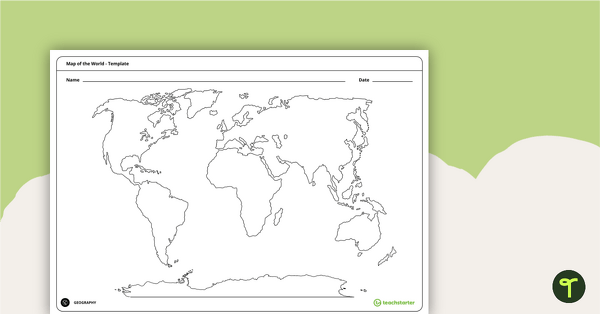
Blank Map of the World - Template
Teach your students about the world’s seven continents and five oceans with this blank map of the world for labelling.
- Plus Plan

World Map Poster
Teach your students about the continents and countries of the world with this detailed map.
- Plus Plan

Features of Maps - Exit Tickets
Assess student map and globe skills with twenty exit ticket worksheets.
- Free Plan

Features of Maps - Worksheet
Apply knowledge of the components of a map to this map elements worksheet.
- Plus Plan
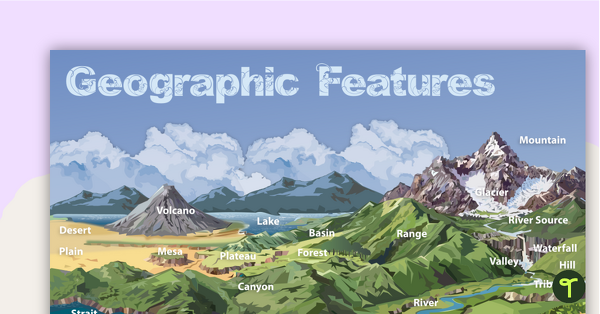
Geographic Landforms Features Poster and Worksheet
Add this poster of different types of geographic features of Earth to your classroom walls to provide a visual reference for students.
- Free Plan

Continents and Oceans Bingo
Turn Geography into a fun and educational learning experience by using our Continents and Oceans Bingo Game!
- Plus Plan

Australian Landform Map
A map of Australia showing the major landforms.
- Plus Plan

People, Places and Connections (Far) - Teaching Presentation
Explore your students’ connections with distant people and places with this comprehensive 20-slide editable teaching presentation.
- Plus Plan
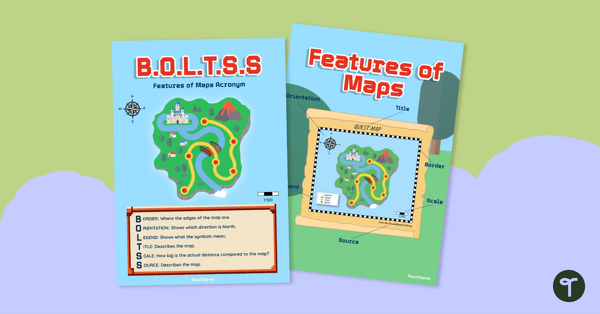
B.O.L.T.S.S Features of Maps Posters for the Classroom
Teach the BOLTSS mnemonic and explore the features of maps using this set of colourful classroom posters.
- Plus Plan

Old vs New Communication Devices - Sorting Activity
A fun sorting activity for students to identify old and new communication devices.
- Free Plan

Transport Then and Now - Worksheet
A set of 2 worksheets for students to identify how transport has changed over time.
- Free Plan

Communication Changes Over Time Worksheet
A sequencing activity to use when exploring how communication devices have changed over time.
- Plus Plan

People, Places and Connections (Near) - Teaching Presentation
Explore your students’ connections with local people and places with this comprehensive 25-slide editable teaching presentation.
- Free Plan

Map of the World - Labelling Activity
Discover and label the world's continents and oceans with this blank map of the world.
- Plus Plan

The World's Continents and Oceans – Teaching Presentation
Explore the seven continents and five oceans of the world with this comprehensive teaching presentation.
- Free Plan

Then and Now - Toy Dominoes
A set of 12 domino playing cards for students to match pictures of toys from the past with the present.
- Free Plan

Communication Then and Now - Worksheet
A worksheet for students to illustrate how communication methods and devices have changed over time.
- Free Plan

Describing Toys Past and Present - Worksheet
A worksheet for students to describe the features of past and present toys.
- Plus Plan

Communication - Past, Present and Future PowerPoint
A 13 slide editable PowerPoint template to use when comparing present day communication devices and their uses with the past.
- Plus Plan

Transport - Past, Present and Future PowerPoint
An 11 slide editable PowerPoint template to use when comparing different modes of transport and their uses from today with the past.
- Plus Plan

Features of Maps - Teaching Presentation
Explore the most common features of maps with this engaging teaching presentation.
- Plus Plan
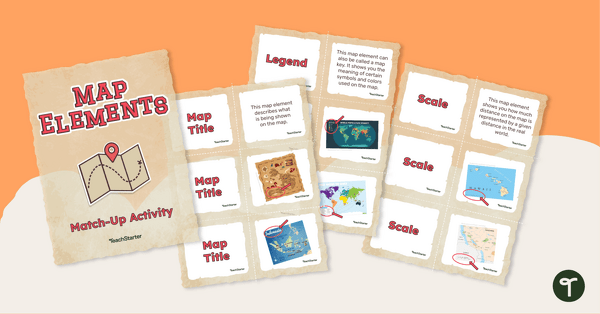
Elements of a Map Match-up Activity
Use knowledge of the features of a map with this map element matching game.
- Plus Plan

Continents and Oceans Worksheet
A worksheet to practise identifying the 7 continents and 5 oceans.
- Free Plan

Past and Present Communication Board Game
A fun and engaging board game to consolidate students' understanding of past and present communication devices.
- Plus Plan

Transport Time Machine - Past and Present Transport Sorting Activity
A fun sorting game for students to identify past modes of transport from the present.
- Plus Plan

Comparing Communication Devices from Past to Present - Worksheet
A worksheet for students to compare communication devices from the past with the present.
- Free Plan
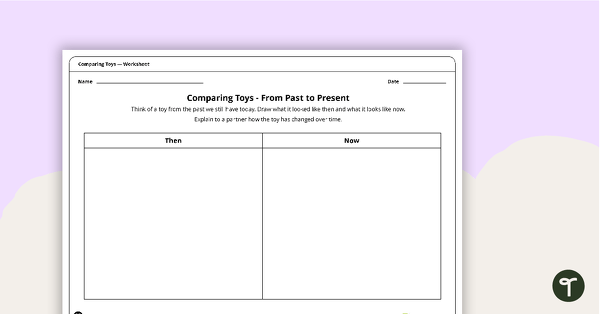
Comparing Toys from Past to Present - Worksheet
A worksheet for students to illustrate how toys have changed over time.
- Plus Plan

Toys - Past, Present and Future PowerPoint
A 15 slide editable PowerPoint template to use when comparing toys from today with the past.
- Free Plan

World Continents Brochure - Template
Replace your continents worksheets with a printable continents brochure project.